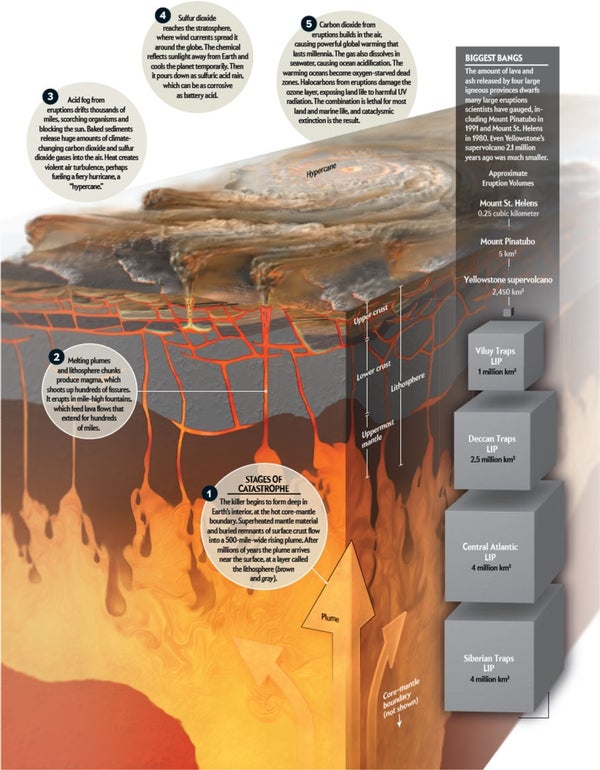The biggest extinctions in our planet's history have been blamed, at various times, on asteroids, gas-emitting microbes or volcanic eruptions. The five mass die-offs destroyed most animals and plants on Earth, including the dinosaurs 66 million years ago. New evidence points strongly to cataclysmic eruptions as the real culprits.Highly accurate rock dates pin such eruptions to the same times as four of the major extinctions and tie the explosions to lethal changes in the atmosphere, as the illustrations here show.
For example, 251.9 million years ago life collapsed in the Permian extinction. More than 95 percent of marine species and 70 percent of land species vanished. At around this period, there was a tremendous amount of volcanic activity in a region called the Siberian Traps. To see if the geologic activity began before the extinction and could have been at fault, geochronologists Seth Burgess and Samuel Bowring of the Massachusetts Institute of Technology and their colleagues went to Siberia to nail down the timing.
The scientists collected tiny crystals of zircon and perovskite from erupted rocks. When the crystals are formed, they contain uranium, which converts to lead at a steady rate after the crystals cool on Earth's surface; the ratio of uranium to lead reveals how long ago the eruption occurred. Most of the erupted rock made it to the planet's surface starting just 300,000 years before the extinction peaked, the team reported in August 2015 in the journal Science Advances. Geochemists have also found signs of a huge burst of carbon dioxide—another lethal eruption consequence—into the atmosphere at this time, a pattern repeated for the extinctions at the end of the Devonian, Triassic and Cretaceous periods.
On supporting science journalism
If you're enjoying this article, consider supporting our award-winning journalism by subscribing. By purchasing a subscription you are helping to ensure the future of impactful stories about the discoveries and ideas shaping our world today.
These are not everyday eruptions. The blowups come from giant fields, sometimes thousands of miles across, strewn with volcanic vents. Geologists call these areas “large igneous provinces” (LIPs). Their remnants today form vast swaths of hardened lava in remote areas of Asia and elsewhere. Large igneous province eruptions are spectacular: magma bursts into the air in mile-high incandescent fountains, yellow-hot lava forms long rivers, and a scorching, sulfurous haze drifts for miles. But it is not the lava or ash that makes extinctions truly “mass”; the sulfur dioxide and carbon dioxide gases drive the lethal death spirals.
Some of the new dates have prompted geophysicist Mark Richards of the University of California, Berkeley, and geologist Walter Alvarez, who helped originate the asteroid impact theory of dinosaur demise, to refine that idea. In an April 2015 paper published in GSA Bulletin, their team suggests that energy from the asteroid slamming into the planet accelerated the most violent eruptions in the Cretaceous era. Thus combined with volcanoes, the impact theory, unlike the dinosaurs, lives on.

